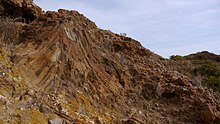Volcanoes of the Campo de Cartagena


The volcanoes of Campo de Cartagena ( Spanish Volcanes del Campo de Cartagena ) in southeastern Spain are witnesses to one of the most recent volcanic events on the Iberian Peninsula . In the Upper Miocene , about 7 million years ago, numerous eruptions occurred in the region. The remains of it can be seen in the islands of the Mar Menor , Isla Grosa , El Carmolí and the Cabezo Beaza .
The volcanic processes were triggered by the subduction of the African plate under the Eurasian plate . They corresponded to the Stromboli type, but without great violence, so that only small stratovolcanoes formed, which are also heavily eroded today. Remnants of these eruptions are pyroclastic flows and lava flows , which can be clearly seen especially on the Cabezo Negro de Tallante . Examples of lava columns can also be found on Isla Grosa . The best examples of volcanic activity, however, can be found at Cabezo del Carmolí , where pyroclastic flows, lava flows, lava columns and small lava domes .
The first volcanic activities occurred in the east of the Campo de Cartagena, during the Miocene between 7.2 and 6.6 million. Years. These effusions were Kalko-Alcaline-Potassium- Andesite . The more recent eruptions occurred about 2.6 million years ago during the Pleistocene , in the northeast of the Campo de Cartagena, more precisely in the area of Tallante , with the outpouring of alkaline basalts . The last volcanic activity was around 1 million years ago on the Cabezo Negro de Tallante
Along with the eruptions, there were tremendous hydrothermal processes as water with dissolved salts rose from the earth's interior. This resulted in the formation of rich mineral deposits in the faults of the Sierra minera de Cartagena-La Unión , including galena (galena), sphalerite (blenda), pyrite , chalcopyrite and magnetite .
The andesites of the Cabezo Beaza were widely used for construction in ancient times. Examples can be found above all in Cartagena: the amphitheater or the Torre Ciega tomb .
The main volcanoes of the Campo de Cartagena
There are five volcanic islands in the Mar Menor basin :
- Isla Mayor (Isla del Barón) 93.8 ha, 104 m altitude. With two main cones and two smaller ones, all of which are heavily aroded.
- Isla Perdiguera , the most visited of the islands with 25.8 hectares. Like the Isla del Barón, it consists of two main cones and a smaller one connected by a tombolo .
- Isla del Ciervo , 16.3 ha The island is home to some interesting endemic Ibero-African floral elements and has therefore been placed under protection as a Microrreserva Botánica . A few decades ago it was connected to La Manga del Mar Menor by an artificial dam, which was removed to protect the flora.
- Isla Rondella o Redonda with a single cone.
- Isla del Sujeto , 2.4 ha. The only island with a more or less recognizable crater .
Outside the Mar Menor, in the Mediterranean , is Isla Grosa with the neighboring volcanic island of El Farallón (Islote del Farallón).
On the mainland, in Campo de Cartagena are:
- El Carmolí
- As a group at the Polígono Industrial de Cartagena ( Cartagena Industrial Area):
- On the Manga del Mar Menor:
- in the Tallante area :
- Volcán Aljorra .
Isla Grosa, Isla Mayor and Isla Perdiguera belong to the Municipio San Javier , the other volcanoes are in the Municipio Cartagena .
Landscape protection
The different landscape areas are also subject to very different protection regulations.
- El Carmolí with the Cinco Islas Volcánicas del Mar Menor are protected as Espacios abiertos e Islas del Mar Menor as Parque Natural , Bird Protection Directive (ZEPA) and Lugar de importancia comunitaria (LIC). Nevertheless, part of the slopes of El Carmolí was built on.
- Isla Grosa and Islote del Farallón are protected as Islas e Islotes del Litoral Mediterráneo of the Region de Murcia as Parque Natural and ZEPA.
- Cabezo Negro de Tallante , Volcán Aljorra and Cabezo de la Fraila were included as Lugares de Importancia Geológica in the new Plan General de Ordenación Urbana (PGOU) of Cartagena.
- The other volcanic elements are not specifically protected.
gallery
Isla del Barón in the Mar Menor .
Andesite in the construction of the Anfiteatro romano de Cartagena .
Individual evidence
- ↑ Región de Murcia Digital: Volcanes de la Región de Murcia
- ^ Pedro Antonio López Sánchez: El distrito minero de Cartagena. Grupo Mineralógico de Alicante.
- ↑ Antonio del Ramo: Volcanes en la Región de Murcia. Episodios volcánico. Región de Murcia Digital.
- ↑ flora protegida: Isla del Ciervo







